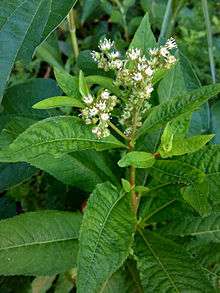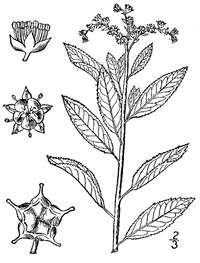Penthorum sedoides
Penthorum sedoides, known by the common name ditch stonecrop, is a perennial forb native to the eastern United States and Canada[1] which produces small white flowers in summer.
| Penthorum sedoides | |
|---|---|
 | |
| Scientific classification | |
| Kingdom: | Plantae |
| Clade: | Tracheophytes |
| Clade: | Angiosperms |
| Clade: | Eudicots |
| Order: | Saxifragales |
| Family: | Penthoraceae |
| Genus: | Penthorum |
| Species: | P. sedoides |
| Binomial name | |
| Penthorum sedoides | |
Description

Penthorum sedoides is 10 to 80 centimeters tall. The erect lower portion of the stem is smooth, but the curved branching inflorescence is covered in glandular hairs. The lanceolate finely serrated leaves are 2 to 18 centimeters long, and 0.5 to 5.5 centimeters wide. The flowers are about half a centimeter wide, with 10 stamens and no petals. The fruit is a star shaped capsule consisting of 5 carpels united at the base, which turns red in autumn.[2][3][4][5]
Distribution and habitat
Penthorum sedoides is widely distributed in the United States and Canada. It has been recorded in the states of Alabama, Arkansas, Connecticut, Washington, D.C., Delaware, Florida, Georgia, Iowa, Illinois, Indiana, Kansas, Kentucky, Louisiana, Massachusetts, Maryland, Maine, Michigan, Minnesota, Missouri, Mississippi, North Carolina, North Dakota, Nebraska, New Hampshire, New Jersey, New York, Ohio, Oklahoma, Oregon, Pennsylvania, Rhode Island, South Carolina, South Dakota, Tennessee, Texas, Virginia, Vermont, Washington, Wisconsin, and West Virginia, as well as the Canadian provinces of British Columbia, Manitoba, New Brunswick, Ontario, and Quebec. It is listed as a species of special concern by the state of Rhode Island. Penthorum sedoides is only native to the eastern half of the continent, in the Pacific Northwest it is an introduced species found in commercial cranberry bogs.[1][4] In Virginia, Penthorum sedoides grows in habitats such as alluvial swamps, floodplain pools, rocky or sandy shores, fens, marshes, beaver ponds, and disturbed wetlands.[6]
References
- "Plants Profile for Penthorum sedoides (Ditch stonecrop)". Retrieved March 17, 2014. USDA, NRCS. 2014. The PLANTS Database (http://plants.usda.gov). National Plant Data Team, Greensboro, NC 27401-4901 USA.
- Britton, Nathaniel Lord & Brown, Addison (1913). An Illustrated Flora of the Northern United States, Canada and the British Possessions: From Newfoundland to the Parallel of the Southern Boundary of Virginia, and from the Atlantic Ocean Westward to the 102d Meridian, Volume 2., p. 211. Charles Scribner's Sons, New York.
- "Penthorum sedoides - Michigan Flora". Retrieved March 17, 2014. MICHIGAN FLORA ONLINE. A. A. Reznicek, E. G. Voss, & B. S. Walters. February 2011. University of Michigan.(http://michiganflora.net)
- "Penthorum sedoides in Flora of North America @ efloras.org". Retrieved March 17, 2014. 'eFloras (2008). Published on the Internet (http://www.efloras.org). Missouri Botanical Garden, St. Louis, MO & Harvard University Herbaria, Cambridge, MA.
- "Penthorum sedoides (ditch-stonecrop): Go Botany". Retrieved March 17, 2014.
- "Digital Atlas of the Virginia Flora | Penthorum sedoides L." Retrieved March 17, 2014. Virginia Botanical Associates. (2014). Digital Atlas of the Virginia Flora (http://www.vaplantatlas.org). c/o Virginia Botanical Associates, Blacksburg.